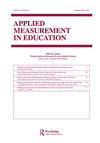个性化在线学习,考试公平和教育测量:在高风险的课程考试结束之前考虑不同的内容暴露
IF 1.1
4区 教育学
Q3 EDUCATION & EDUCATIONAL RESEARCH
引用次数: 1
摘要
根据《教育与心理测试标准(2014)》,考试公平的一个方面是考生在考试前有相当的学习机会。与此同时,许多研究人员正在开发由人工智能(AI)增强的平台,可以根据学生的个性化需求定制课程。这就引出了一个更大的首要问题:当个性化学习导致学生在整个K-12学年中对课程有不同的接触时,这将如何影响总结性、年终高风险考试的考试公平性?作为第一步,我们追踪了与个性化学习和更传统的学习路径相关的内容暴露的差异。为了更好地理解内容覆盖差异的影响,我们进行了一项模拟研究,以评估在特定的人工智能增强学习平台上,学生对高中代数教学的课程接触程度的差异。结果表明,人工智能增强的个性化学习可能会对K-12总结性高风险考试的考试公平性构成威胁。我们讨论了测试在教育中的作用的不同观点的含义本文章由计算机程序翻译,如有差异,请以英文原文为准。
Personalized Online Learning, Test Fairness, and Educational Measurement: Considering Differential Content Exposure Prior to a High Stakes End of Course Exam
ABSTRACT According to the Standards for Educational and Psychological Testing (2014), one aspect of test fairness concerns examinees having comparable opportunities to learn prior to taking tests. Meanwhile, many researchers are developing platforms enhanced by artificial intelligence (AI) that can personalize curriculum to individual student needs. This leads to a larger overarching question: When personalized learning leads to students having differential exposure to curriculum throughout the K-12 school year, how might this affect test fairness with respect to summative, end-of-year high-stakes tests? As a first step, we traced the differences in content exposure associated with personalized learning and more traditional learning paths. To better understand the implications of differences in content coverage, we conducted a simulation study to evaluate the degree to which curriculum exposure varied across students in a particular AI-enhanced learning platform for Algebra instruction with high-school students. Results indicate that AI-enhanced personalized learning may pose threats to test fairness as opportunity-to-learn on K-12 summative high-stakes tests. We discuss the implications given different perspectives of the role of testing in education
求助全文
通过发布文献求助,成功后即可免费获取论文全文。
去求助
来源期刊

Applied Measurement in Education
Multiple-
CiteScore
2.50
自引率
13.30%
发文量
14
期刊介绍:
Because interaction between the domains of research and application is critical to the evaluation and improvement of new educational measurement practices, Applied Measurement in Education" prime objective is to improve communication between academicians and practitioners. To help bridge the gap between theory and practice, articles in this journal describe original research studies, innovative strategies for solving educational measurement problems, and integrative reviews of current approaches to contemporary measurement issues. Peer Review Policy: All review papers in this journal have undergone editorial screening and peer review.
 求助内容:
求助内容: 应助结果提醒方式:
应助结果提醒方式:


